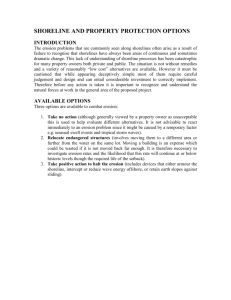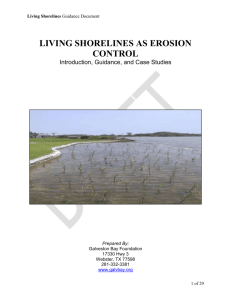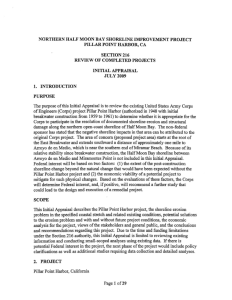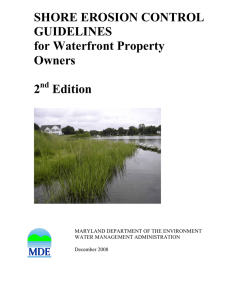Methods of Shoreline Protection Notes
advertisement
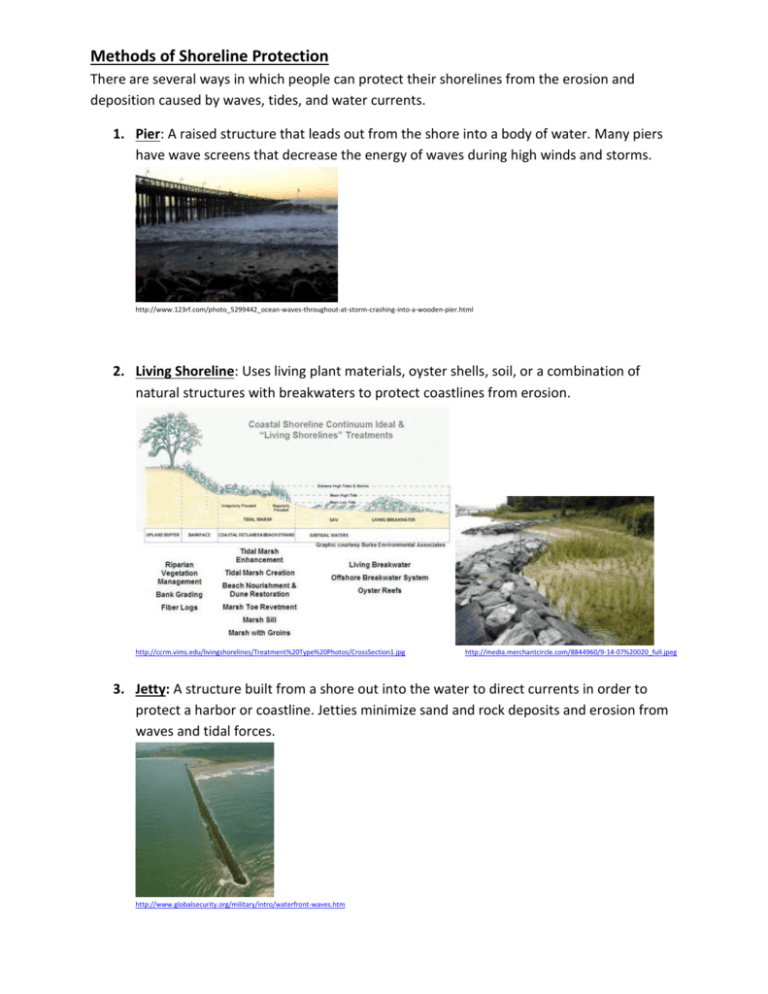
Methods of Shoreline Protection There are several ways in which people can protect their shorelines from the erosion and deposition caused by waves, tides, and water currents. 1. Pier: A raised structure that leads out from the shore into a body of water. Many piers have wave screens that decrease the energy of waves during high winds and storms. http://www.123rf.com/photo_5299442_ocean-waves-throughout-at-storm-crashing-into-a-wooden-pier.html 2. Living Shoreline: Uses living plant materials, oyster shells, soil, or a combination of natural structures with breakwaters to protect coastlines from erosion. http://ccrm.vims.edu/livingshorelines/Treatment%20Type%20Photos/CrossSection1.jpg http://media.merchantcircle.com/8844960/9-14-07%20020_full.jpeg 3. Jetty: A structure built from a shore out into the water to direct currents in order to protect a harbor or coastline. Jetties minimize sand and rock deposits and erosion from waves and tidal forces. http://www.globalsecurity.org/military/intro/waterfront-waves.htm 4. Groyne: A barrier that extends from the shore out into the ocean. It is similar to, but much smaller than, a jetty. Groins are aligned with the shore to prevent the movement of water and transport of materials toward the shore. http://s0.geograph.org.uk/geophotos/01/50/32/1503224_80186290.jpg 5. Bulkhead/Breakwater/Rip Rap: Barriers constructed along shorelines to control beach and landslide erosion caused by wave action. They are commonly made out of wood, commercially developed vinyl products, large boulders stacked to form a wall, or concrete. http://www.ecastles.co.uk/breakwaterfp.jpg http://www.rivaphotos.com/cart/images/Breakwater%201.JPG 6. Seawall: Similar to bulkhead/breakwater, but most commonly made out of concrete or cement to form a thick, tall wall. http://marineinsight.com/wp-content/uploads/2010/12/SeaWall_Japan.jpg 7. Revetment: Sloping structures placed on banks or cliffs in such a way that they absorb the energy of incoming waves, to lessen the damage of erosion. Revetments can be made out of various materials such as wood, boulders, rocks, or concrete. http://blackpoolsixthasgeography.pbworks.com/f/revetment.jpg 8. Gabion Basket: Cages filled with rocks, concrete, or sand that act as a caged rip rap to protect shorelines and land from erosion. They are heavy and can conform to ground movement, so they are not washed away easily (while rip raps alone are). http://www.toboc.com/images/TRADELEADS/269263_HR.JPG http://www.toboc.com/images/TRADELEADS/291892_HR.JPG 9. Soil Mat: Mats of fabric that contain soil that are laid out along a shoreline (mainly around lakes) to prevent erosion of the land. http://geosyntheticsmagazine.com/repository/2/8754/large_0606_f6_2.jpg 10. Cliff Stabilization: A technique used to control coastal erosion; the cliffs are stabilized through dewatering (draining excess water) or anchoring (wiring or anchoring the cliff to stabilize it). http://www.southwestcoastalgroup.org.uk/images/cc_gabions_types.jpg 11. Beach Replenishment: Beach replenishment or nourishment is one of the most popular soft engineering techniques of coastal defense management schemes. This involves importing sand off the beach or from the ocean floor and piling it on top of the existing sand. http://en.wikipedia.org/wiki/File:Beach_restoration_device.jpg






